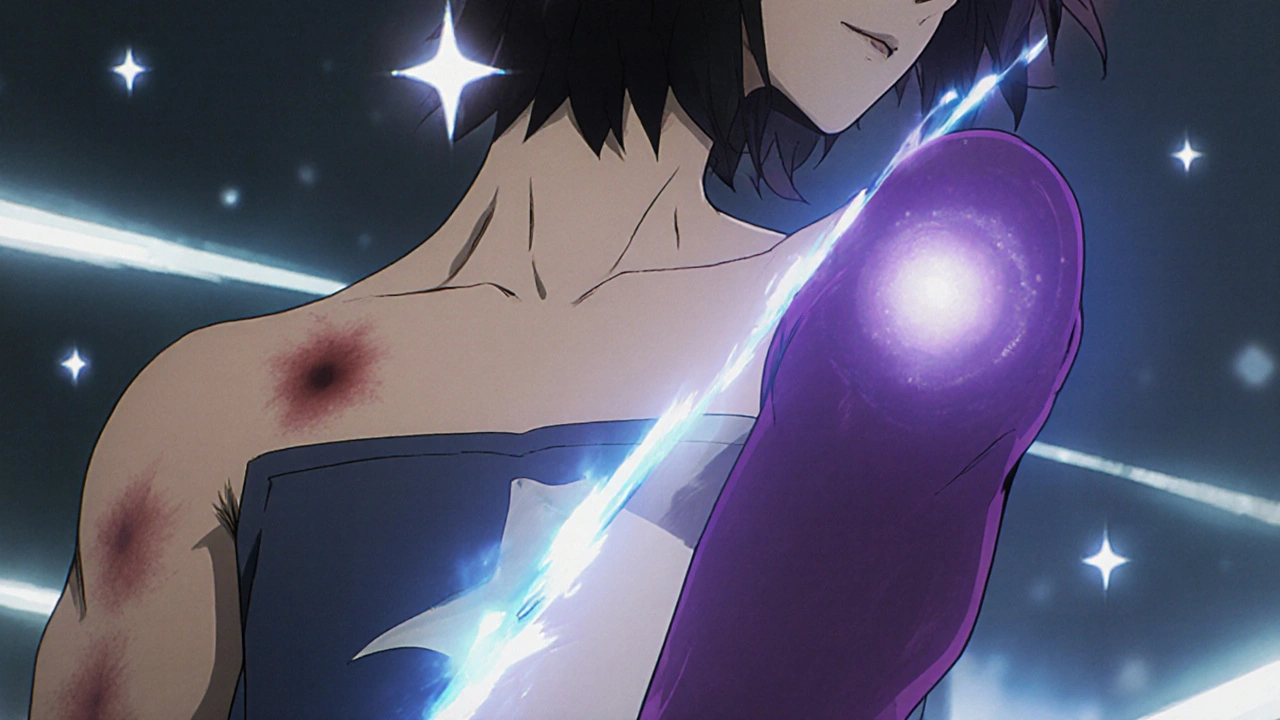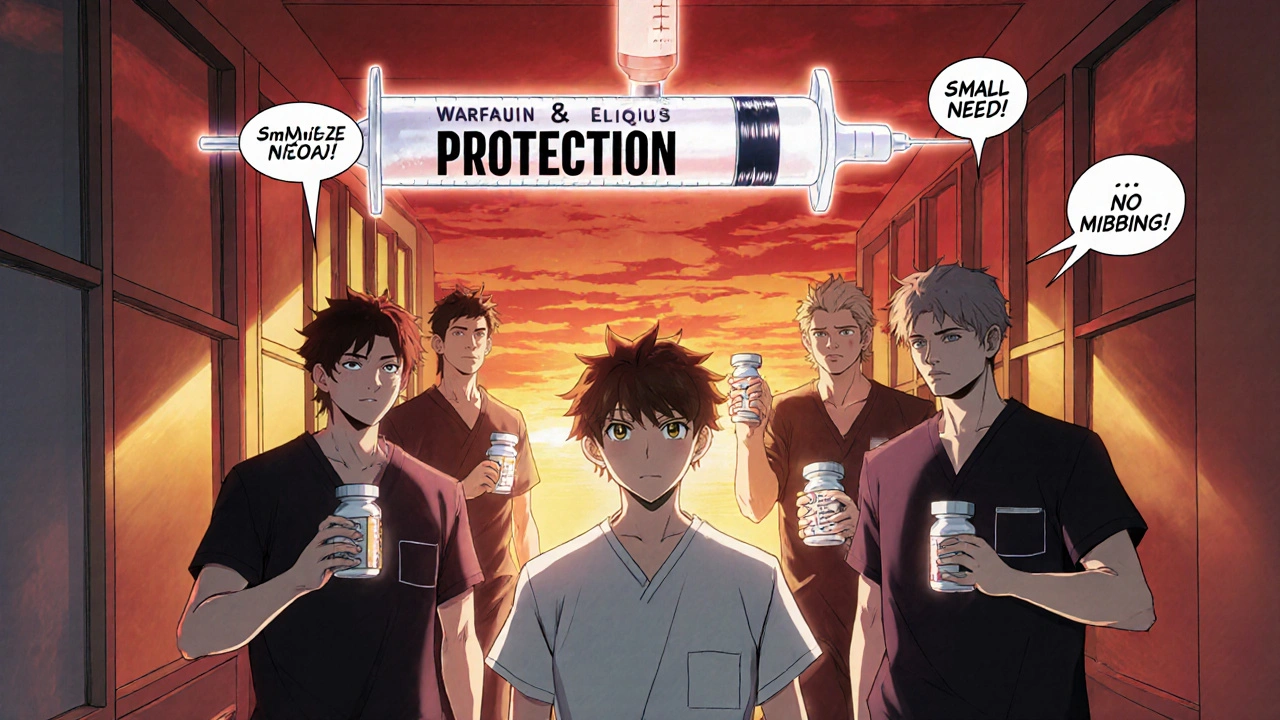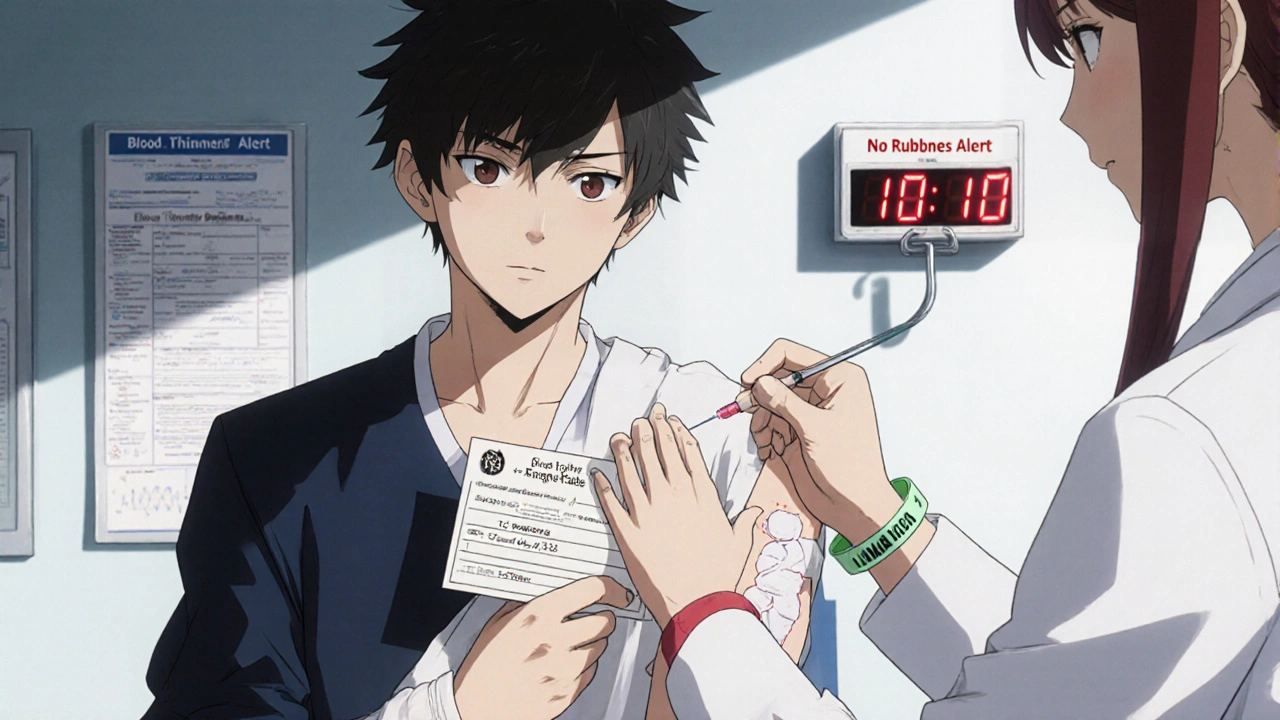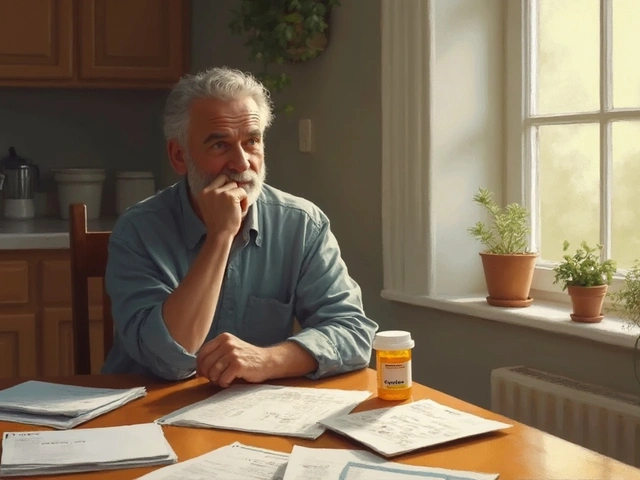Vaccination Checklist for Blood Thinners
Your Blood Thinner Type
Preparation Checklist
Before your appointment: Don't take aspirin or NSAIDs (ibuprofen, naproxen) for 24-48 hours before vaccination
Before your appointment: Use acetaminophen (Tylenol) for pain if needed
Before your appointment: Check your INR if on Warfarin (should be below 4.0)
At your appointment: Tell your provider you're on blood thinners
At your appointment: Request a small needle (23-gauge or smaller)
At your appointment: Request firm pressure for at least 10 minutes
At your appointment: Ask for no rubbing after injection
At your appointment: Confirm vaccination site is upper arm (deltoid)
After your appointment: Apply ice for 24 hours if bruising occurs
Key Information
Please select your blood thinner type above to see specific instructions relevant to your medication.
What to Do If You Experience Bruising
Minor bruising is common - usually fades in 7-10 days. If bruising:
- Is larger than a golf ball
- Increases pain or swelling after 24 hours
- Causes numbness or tingling in your arm
- Bleeding doesn't stop after 10 minutes of pressure
Call your doctor immediately.
Apply ice for the first 24 hours. After that, use warm compresses to help reabsorb the blood.
Use acetaminophen (Tylenol) for pain relief only. Avoid NSAIDs for 2-3 days after vaccination.
Getting Vaccinated While on Blood Thinners Is Safe - If You Do It Right
You’re on blood thinners. Maybe it’s warfarin, Eliquis, Xarelto, or another anticoagulant. You know you need the flu shot, the pneumonia vaccine, or your COVID booster. But you’ve heard stories - someone got a huge bruise, another had bleeding that wouldn’t stop. So you hesitate. You wonder: Is it safe? The answer is yes - if you and your provider follow the right steps.
Millions of people on blood thinners get vaccinated every year without issues. The CDC, the American College of Chest Physicians, and the Anticoagulation Forum all agree: the risk of catching the flu, COVID, or pneumonia is far greater than the small chance of a bruise. But that small chance? It’s real. And it’s preventable.
Why Blood Thinners Make Vaccination Trickier
Most vaccines - flu, COVID, pneumococcal, shingles - are given as intramuscular injections. That means the needle goes deep into muscle, usually the deltoid in your upper arm. When you’re on blood thinners, your blood doesn’t clot as quickly. So when the needle punctures small blood vessels, they can keep bleeding longer than normal. That leads to bruising, swelling, or even a hematoma - a collection of blood under the skin.
It’s not dangerous for most people, but it’s painful. And if it’s big enough, it can limit your arm movement for days. Worse, if your provider doesn’t know you’re on blood thinners, they might use the wrong needle, skip pressure, or rub the site - all things that make bleeding worse.
What Type of Blood Thinner You’re On Matters
Not all blood thinners are the same. And that affects how you prepare.
- Warfarin (Coumadin): This one needs monitoring. Your INR level - a blood test that measures how long it takes your blood to clot - should be checked before vaccination. Most guidelines say it’s safe if your INR is below 4.0. If it’s higher, your doctor might delay the shot or adjust your dose. A 2023 study from the American Society of Hematology found patients with INR above 4.0 had a 37% higher chance of serious bruising.
- DOACs (Eliquis, Xarelto, Pradaxa, Savaysa): These newer drugs don’t need regular blood tests. You don’t need to stop them or check levels. Just take your normal dose. But timing matters. Some experts suggest scheduling your shot when the drug concentration is lowest - usually 12 hours after your last dose - to reduce bleeding risk.
- Heparin or low molecular weight heparin (Lovenox): If you’re on daily injections, you can still get your vaccine. But use a smaller needle and apply firm pressure longer.
- Severe hemophilia (Factor VIII or IX under 1%): This is a special case. You need prophylactic factor replacement before any injection. Talk to your hematologist - don’t assume your primary care provider knows this.

The Right Technique Makes All the Difference
Here’s what your provider should do - and what you should ask for:
- Use a small needle. A 23-gauge or smaller needle is best. Thinner needles cause less tissue damage. Many providers still use 22-gauge needles out of habit - ask for a smaller one.
- Don’t rub the site. After the shot, they should press down firmly - no rubbing, no massaging. Rubbing spreads the blood under the skin and makes bruising worse.
- Apply pressure for at least 10 minutes. The CDC says 2-5 minutes for most people. But if you’re on blood thinners, 10 minutes is safer. The Bleeding & Clotting Disorders Institute recommends this for all anticoagulated patients. Hold it steady. Don’t check early. Set a timer.
- Don’t use aspirin or NSAIDs before. No Advil, no ibuprofen, no aspirin for 24-48 hours before the shot. These can make bleeding worse. Acetaminophen (Tylenol) is fine if you need pain relief.
- Get the shot in your deltoid. Avoid the thigh unless you’re obese or have other reasons. The upper arm gives better control and less risk of hitting major vessels.
One patient on Reddit, on Xarelto, said: “My nurse used a 25-gauge needle, pressed for 10 minutes, no bruise. My last shot? Big purple lump. The nurse didn’t even know I was on blood thinners.”
What to Do If You Get a Bruise
Minor bruising is common - about 68% of people on blood thinners report it, according to a Reddit survey. But if you notice:
- A lump bigger than a golf ball
- Increasing pain or swelling after 24 hours
- Numbness or tingling in your arm
- Bleeding that doesn’t stop after 10 minutes of pressure
Call your doctor. You might have a hematoma that needs monitoring. Most resolve on their own, but large ones can compress nerves or take weeks to clear.
Apply ice for the first 24 hours. After that, warm compresses help the body reabsorb the blood. Don’t take anything stronger than acetaminophen for pain. Avoid blood thinners like fish oil or high-dose vitamin E for a few days after.
Don’t Let Your Provider Guess - Tell Them
Here’s the scary part: 29% of anticoagulated patients say their vaccinator didn’t adjust technique at all, according to the National Blood Clot Alliance. That means nearly one in three people got a shot the wrong way.
Don’t assume they know. Say it clearly: “I’m on blood thinners. I need a small needle and 10 minutes of firm pressure - no rubbing.” Bring a printed note if you have to. Some clinics now use “Blood Thinner Alert” wristbands - ask if yours does.
Also, make sure your vaccination record includes your anticoagulant use. The VAERS system found 43% of bleeding complications happened because the provider didn’t know you were on blood thinners.

What About Vaccine Interactions?
There’s no evidence that vaccines make blood thinners work differently - except for one rare case with warfarin. A 2004 report from New Zealand noted a few cases where INR spiked after the flu shot, sometimes as high as 10. But it’s rare. No similar cases have been seen with DOACs.
Still, if you’re on warfarin, get your INR checked 5-7 days after your vaccine. It’s not required, but it’s smart. If your INR is higher than usual, your doctor might adjust your dose. No need to panic - it usually goes back to normal on its own.
And if you’re on other meds like ibrutinib (for leukemia), talk to your oncologist. A 2024 study showed that combining ibrutinib with warfarin increases bleeding risk - even more than warfarin alone.
Bottom Line: Get the Shot. Do It Right.
You’re on blood thinners because you’re at risk for clots. That also puts you at higher risk for serious infections. The flu can land you in the hospital. COVID can kill. Vaccines are your best protection.
The risk of bleeding from a shot? Tiny. And it’s almost always avoidable. With the right needle, the right pressure, and the right communication, you can get vaccinated safely.
Don’t skip your shots. But do speak up. Ask for a small needle. Ask for 10 minutes of pressure. Write it down. Bring it with you. Your body will thank you.
Can I still get vaccinated if my INR is high?
If your INR is above 4.0, it’s safer to delay the shot until your levels are back in range. High INR means your blood takes much longer to clot, increasing the risk of a large hematoma. Talk to your anticoagulation clinic - they may adjust your warfarin dose temporarily. DOACs don’t require INR checks, so this doesn’t apply if you’re on Eliquis, Xarelto, or similar drugs.
Should I stop my blood thinner before getting a vaccine?
No. Never stop your blood thinner without your doctor’s advice. Stopping increases your risk of stroke, pulmonary embolism, or heart attack - far greater than the risk of a bruise. For DOACs, take your dose as usual. For warfarin, don’t skip your pill. Just make sure your provider knows you’re on it and uses proper technique.
Is it better to get the shot in the thigh instead of the arm?
Only if you’re obese or have limited shoulder mobility. The deltoid muscle in the upper arm is preferred because it’s easier to compress with pressure and has fewer large blood vessels. The thigh has more risk of hitting the femoral artery. Unless your provider recommends otherwise, stick with the arm.
How long does bruising last after a vaccine if I’m on blood thinners?
Minor bruising usually fades in 7-10 days. Larger hematomas can take 2-4 weeks to fully clear. If the bruise keeps growing, feels warm, or causes numbness, contact your doctor. Cold packs in the first 24 hours help reduce swelling. After that, warm compresses speed up healing.
Can I take painkillers after the shot?
Yes - but only acetaminophen (Tylenol). Avoid NSAIDs like ibuprofen, naproxen, or aspirin for at least 48 hours after the shot. These drugs interfere with platelet function and can make bleeding worse. If you’re on aspirin for heart protection, don’t stop it - just avoid extra doses.
Do I need to tell my pharmacist if I’m on blood thinners?
Yes - especially if you’re getting vaccines at a pharmacy. Pharmacists aren’t always trained in anticoagulation. Tell them upfront: “I’m on blood thinners. I need a small needle and 10 minutes of pressure.” If they hesitate, ask to speak to the nurse or manager. Your safety matters more than convenience.
Are there vaccines I should avoid if I’m on blood thinners?
No. All standard vaccines - including live vaccines like MMR or shingles - are safe for people on blood thinners. The only exception is if you have a severe bleeding disorder like hemophilia with factor levels under 1%. In that case, you’ll need factor replacement before any injection. For everyone else, get every recommended shot.
What Comes Next
As more people live longer with conditions like atrial fibrillation, the number of people on blood thinners keeps rising. By 2030, nearly 29 million Americans will be on them. Vaccination protocols are getting better - 87% of hospitals now have written guidelines. But it still comes down to you speaking up.
Don’t wait for someone to ask. Don’t assume they know. Say it clearly. Ask for the right technique. Your next shot doesn’t have to be a bruise. It can be peace of mind - and protection.






Alyssa Fisher
November 10, 2025 AT 00:41It’s wild how much of this comes down to communication. I’ve had two shots on Eliquis-first one, the nurse just jabbed and rubbed. Purple moon for a week. Second time, I printed the CDC guidelines, handed them over, and said, ‘Small needle. Ten minutes. No rubbing.’ No bruise. Zero drama. Why is this so hard to teach?
William Priest
November 10, 2025 AT 23:11Wow. So we’re now treating adults like toddlers who need a step-by-step guide just to get a flu shot? Next they’ll hand us a checklist before we breathe. The system’s broken if a patient has to educate the provider. But hey, at least the article’s thorough. I guess that’s something.
Jennifer Bedrosian
November 11, 2025 AT 20:59I got the Moderna shot last year on Xarelto and my arm looked like a crime scene for 10 days. I didn’t say anything because I didn’t want to be ‘that person.’ Now I’m mad. Why didn’t anyone tell me about the 10-minute pressure rule? I could’ve been a superhero with ice packs and patience instead of a bruised mess.
Beth Banham
November 12, 2025 AT 05:42I’m on warfarin and my INR’s usually around 2.8. I always ask for the smallest needle they have. I bring a little notebook with the CDC guidelines printed out. I don’t make a scene. I just hand it over with a smile. Most nurses are grateful. It’s not about being difficult-it’s about being prepared. You’d be surprised how much difference that makes.
Brierly Davis
November 13, 2025 AT 04:32Y’all are killing it with this thread. Seriously. I’m a nurse and I didn’t know about the 10-minute pressure thing until last month. I’ve been doing 2 minutes for years. I just printed this out and taped it to our vaccine station. If you’re on blood thinners-speak up. We want to get it right. We just need to be told.
Jim Oliver
November 14, 2025 AT 10:09So… you’re telling me that people can’t remember to say ‘I’m on blood thinners’? That’s not a medical issue. That’s a cognitive failure. Maybe don’t get vaccines if you can’t say three words. Also, why is this even an article? It’s common sense. I’m surprised we’re still having this conversation.
Jay Wallace
November 15, 2025 AT 04:17As an American who actually pays attention to his health (unlike the rest of you globalists), I’m shocked we even have to TALK about this. In my day, you got your shot, you shut up, and you didn’t whine about a little bruise. Back in ’08, we didn’t have 25-gauge needles-we had pride. And we didn’t need no stinking guidelines. Just suck it up, patriot.
Ryan Masuga
November 16, 2025 AT 02:23Big thanks to everyone sharing their stories. I’m on Xarelto too and I’ve been too scared to get boosted for months. This thread just gave me the courage to call my clinic tomorrow. I’m bringing the printed list. I’m not asking-I’m telling them what I need. No more fear. No more bruises. Just peace of mind. You guys are the real MVPs.
Lashonda Rene
November 16, 2025 AT 11:01So I just got my booster and I didn’t even know I was supposed to ask for a small needle or not rub it, and I got this huge bruise that looked like a map of the USA, and I was so scared I thought I was dying, but then I looked it up and it was just a hematoma and now I feel dumb for not knowing, but also mad that no one ever told me, and I’m telling you now so you don’t have to go through what I went through, because it’s not just about the shot it’s about being heard and being safe and I just want everyone to know that it’s okay to speak up even if you feel weird about it because your body matters more than someone’s bad habits
Ankit Yadav
November 17, 2025 AT 03:41From India-just wanted to say this is brilliant advice. Here, many clinics still use 22-gauge needles for everyone. I showed my doctor this article and he changed his practice. No one asked before. Now, we have a small poster: ‘Ask for 25-gauge + 10 min pressure.’ Simple. Effective. Thank you for writing this.
Rashmi Mohapatra
November 18, 2025 AT 08:18Why are you all so obsessed with needles and pressure? In my country we just take our medicine and get the shot and if we bruise then we bruise. You Americans think everything needs a manual. Just chill. God will protect you. Also, your INR is what now? I don’t even know what that means
Abigail Chrisma
November 18, 2025 AT 18:48My mom’s on warfarin and she’s 79. She walks into every appointment with a laminated card that says: ‘I’m on warfarin. Please use a 25-gauge needle and apply 10 minutes of direct pressure. No rubbing. Thank you.’ She’s not rude. She’s prepared. And she’s never had a bad bruise. If you’re scared to speak up, just write it down. It’s not confrontation-it’s care.
Andy Slack
November 20, 2025 AT 09:40Just got my shot today. Small needle. 10 minutes. No rubbing. Zero bruise. I didn’t even feel it. That’s it. That’s the whole story. You don’t need a PhD. You just need to say the words. Do it. Your arm will thank you.
Alyssa Salazar
November 21, 2025 AT 03:14Let’s not forget the real issue here: systemic neglect of anticoagulated patients. This isn’t about ‘patient education’-it’s about provider training. If 29% of vaccinators don’t adjust technique, that’s not patient failure-that’s institutional failure. We need mandatory CE modules on anticoagulation safety in every clinic, pharmacy, and hospital. This isn’t a Reddit thread. It’s a public health mandate.